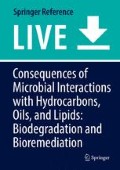Abstract
For several decades, there has been a conflict between those who release pollutants into the environment and/or own polluted sites and those who wish those releases to be curtailed and want contaminated sites to be remediated. The polluters have generally been businesses that are most interested in controlling costs and maximizing profits or government agencies who often had other priorities of national interest (e.g., war efforts). Those opposed to pollution have sought to reduce the exposure risks of toxic chemicals and to ensure the sustainability of the natural environment. Some of these conflicts came to a peak in the 1970s in the United States, and they ultimately led to the creation of strong environmental laws that forced polluters to control emissions and to reduce the risk associated with contaminants on their sites. As a result of these new rules, a profit-driven environmental remediation and pollution control industry also emerged. The goal of this industry is primarily to help the polluters meet their regulatory requirements by developing and applying remedial technologies, helping the companies or agencies evaluate and implement technologies as they emerge, and/or ensuring regulatory compliance. During my 25-year career in this environmental remediation industry, I observed how technologies were selected for application at given sites, and I learned about the many subtle factors and conflicting interests that affected such decisions. I also observed the role that scientists can play in this high-stakes game that pits the profit motives of two parties and the legal requirements of a third party against one another to, hopefully, meet the needs of all parties. Herein I describe some of the lessons I learned with the hope of helping current and future scientists and entrepreneurs to develop and market successful technologies to improve waste treatment and pollution remediation.
References
Bej AK, Steffan RJ, DiCesare J, Haff L, Atlas RM (1990) Detection of coliform bacteria in water by polymerase chain reaction and gene probes. Appl Environ Microbiol 56:307–314
DeFlaun MF, Steffan RJ (2002) Bioaugmentation. In: Bitton G (ed) Encyclopedia of environmental microbiology. Wiley, New York, pp 434–442
Duhamel M, Mo K, Edwards EA (2004) Characterization of a highly enriched Dehalococcoides-containing culture that grows on vinyl chloride and trichloroethene. Appl Environ Microbiol 70:5538–5545
Freedman DL, Gossett JM (1989) Biological reductive dechlorination of tetrachloroethylene and trichloroethylene to ethylene under methanogenic conditions. Appl Environ Microbiol 55:2144–2151
Gale EF (1952) The chemical activities of bacteria. Academic, New York, p 5
Hatzinger PB, McClay K, Vainberg S, Tugusheva M, Condee CW, Steffan RJ (2001) Biodegradation of methyl tert-butyl ether (MTBE) by a pure bacterial culture. Appl Environ Microbiol 67:5601–5607
Major DW, McMaster ML, Cox EE, Edwards EA, Dworatzek SM, Hendrickson ER, Starr MG, Payne JA, Buonamici LW (2002) Field demonstration of successful bioaugmentation to achieve dechlorination of tetrachloroethene to ethene. Environ Sci Technol 36:5106–5116
Maymó-Gatell X, Chien YT, Gossett JM, Zinder SH (1997) Isolation of a bacterium that reductively dechlorinates tetrachloroethene to ethene. Science 276:1568–1571
Maymó-Gatell X, Anguish T, Zinder SH (1999) Reductive dechlorination of chlorinated ethenes and 1,2-dichloroethane by “Dehalococcoides ethenogenes” 195. Appl Environ Microbiol 65:3108–3113
McCarty PL, Goltz MN, Hopkins GD, Dolan ME, Allan JP, Kawakami BT, Carrothers TJ (1998) Full-scale evaluation of in situ cometabolic degradation of trichloroethylene in groundwater through toluene injection. Environ Sci Technol 32:88–100
Squillace PJ, Zogorski JS, Wilber WG, Price CV (1996) Preliminary assessment of the occurrence and possible sources of MTBE in groundwater in the United States, 1993−1994. Environ Sci Technol 30:1721–1730
Steffan RJ, Atlas RM (1988) DNA amplification to enhance the detection of genetically engineered microorganisms in environmental samples. Appl Environ Microbiol 54:2185–2191
Steffan RJ, Schaefer CE (2016) Current and future bioremediation applications: bioremediation from a practical and regulatory perspective. In: Adrian L, Loffler FE (eds) Organohalide-respiring bacteria. Springer, Berlin, pp 517–540
Steffan RJ, McClay K, Vainberg S, Condee CW, Zhang D (1997) Biodegradation of the gasoline oxygenates methyl tert-butyl ether (MTBE), ethyl tert-butyl ether (ETBE), and tert-amyl methyl ether (TAME) by propane oxidizing bacteria. Appl Environ Microbiol 63:4216–4222
Steffan RJ, Sperry KL, Walsh MT, Vainberg S, Condee CW (1999) Field-scale evaluation of in situ bioaugmentation for remediation of chlorinated solvents in groundwater. Environ Sci Technol 33:2771–2781
Steffan RJ, Condee C, Quinnan J, Walsh M, Abrams SH, Flanders J (2000) In situ application of propane sparging for MTBE bioremediation. In: Wickramanayake GB, Gavaskar AR, Alleman BC, Magar VS (eds) Bioremediation and phytoremediation of chlorinated and recalcitrant compounds. Battelle Press, Columbus, pp 157–165
United States Patent (1994) Process for detection of water-born microbial pathogens and indicators of human fecal contamination in water samples and kits therefor. U. S. Patent #5,298,392, 29 Mar 1994
Vainberg S, Togna AP, Sutton PM, Steffan RJ (2002) Treatment of MTBE-contaminated water in a fluid bed bioreactor (FBR). J Environ Eng 128:842–851
Vainberg S, Condee CW, Steffan RJ (2009) Large-scale production of bacterial consortia for remediation of chlorinated solvent-contaminated groundwater. J Ind Microbiol Biotechnol 36:1189–1197
Wilson M, Lindow SE (1993) Release of recombinant microorganisms. Annu Rev Microbiol 47:913–944
Author information
Authors and Affiliations
Corresponding author
Editor information
Editors and Affiliations
Rights and permissions
Copyright information
© 2019 Springer Nature Switzerland AG
About this entry
Cite this entry
Steffan, R.J. (2019). Developing Bioremediation Technologies for Commercial Application: An Insider’s View. In: Steffan, R. (eds) Consequences of Microbial Interactions with Hydrocarbons, Oils, and Lipids: Biodegradation and Bioremediation. Handbook of Hydrocarbon and Lipid Microbiology . Springer, Cham. https://doi.org/10.1007/978-3-319-44535-9_26-1
Download citation
DOI: https://doi.org/10.1007/978-3-319-44535-9_26-1
Received:
Accepted:
Published:
Publisher Name: Springer, Cham
Print ISBN: 978-3-319-44535-9
Online ISBN: 978-3-319-44535-9
eBook Packages: Springer Reference Biomedicine and Life SciencesReference Module Biomedical and Life Sciences

